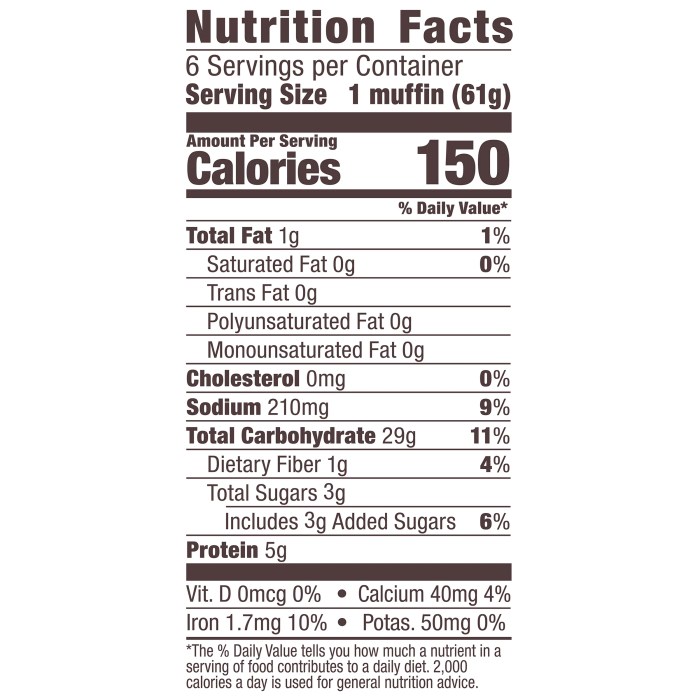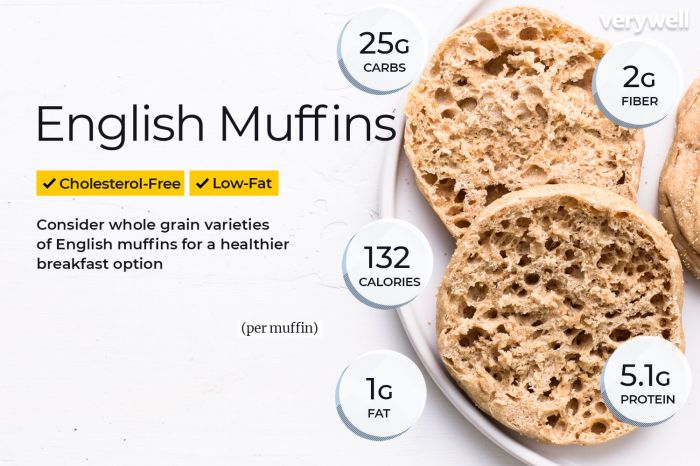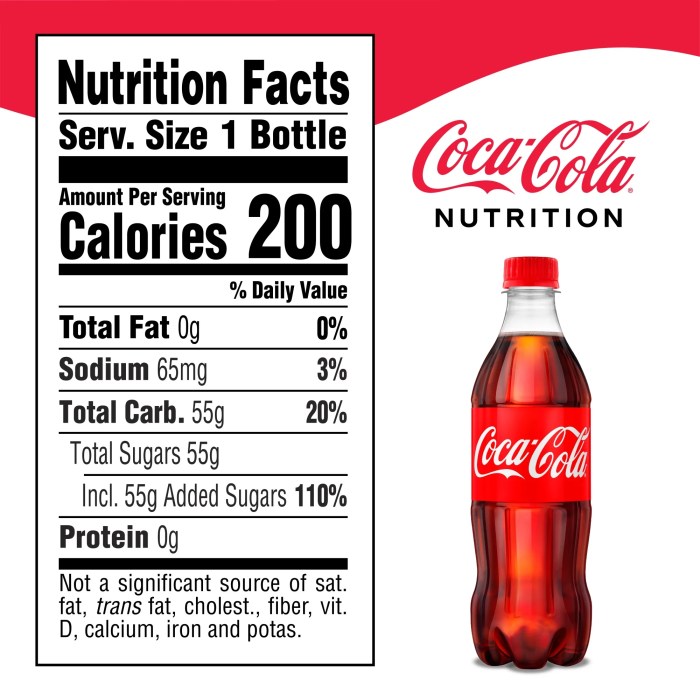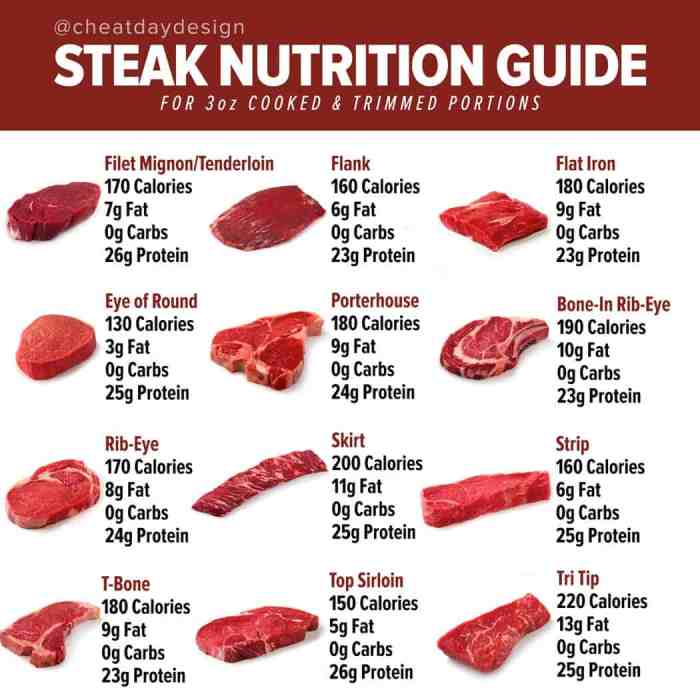Nutritional Composition of English Muffins

English muffin nutrition facts – English muffins, a popular breakfast staple, offer a surprisingly diverse nutritional profile. While often perceived as a simple carbohydrate source, a closer look reveals a more complex composition of macronutrients, micronutrients, and fiber, influencing their impact on overall health and blood sugar levels. Understanding this composition is key to making informed dietary choices.
Macronutrient Breakdown of English Muffins, English muffin nutrition facts
A typical English muffin (approximately 60g) provides a significant amount of carbohydrates, a moderate amount of protein, and a relatively small amount of fat. The exact values can vary depending on the brand and ingredients used, but a general guideline is approximately 30-40g of carbohydrates, 4-6g of protein, and 1-2g of fat. A substantial portion of the carbohydrate content comes from complex carbohydrates, which are digested more slowly than simple sugars.
Understanding English muffin nutrition facts is crucial for balanced eating. While they offer carbohydrates and fiber, it’s helpful to compare their nutritional profile to other hydration options, such as checking the details on liquid iv nutrition facts , to see how they differ in terms of electrolytes and sugars. Ultimately, both choices contribute differently to a healthy diet, depending on individual needs and activity levels.
Furthermore, English muffins are a good source of dietary fiber, typically containing 2-4g per muffin. This fiber is composed of both soluble and insoluble types, contributing to digestive health and satiety. Soluble fiber helps regulate blood sugar levels, while insoluble fiber promotes regular bowel movements.
Micronutrient Profile of English Muffins
English muffins also contribute to the daily intake of several essential vitamins and minerals, though the amounts are typically modest. The following table provides a general overview of the micronutrient content, based on average values found in commercially available English muffins. Note that these values may vary depending on the specific brand and any added ingredients.
| Name | Amount | % Daily Value | Notes |
|---|---|---|---|
| Iron | 1-2mg | 5-10% | Contributes to red blood cell production. |
| Folate | 20-40mcg | 5-10% | Essential for cell growth and development. |
| Niacin | 1-2mg | 5-10% | Important for energy metabolism. |
| Thiamin | 0.1-0.2mg | 5-10% | Plays a role in carbohydrate metabolism. |
| Riboflavin | 0.1-0.2mg | 5-10% | Contributes to energy production. |
| Selenium | 5-10mcg | 5-10% | Acts as an antioxidant. |
Glycemic Index and Glycemic Load of English Muffins
The glycemic index (GI) and glycemic load (GL) are important considerations for individuals managing their blood sugar levels. The GI measures how quickly a carbohydrate-containing food raises blood glucose levels, while the GL considers both the GI and the amount of carbohydrates in a serving. English muffins generally have a moderate to high GI (depending on the specific type and preparation method), ranging from 60-70.
Their GL is also moderate, meaning they can cause a noticeable, but not extreme, rise in blood glucose. This implies that while English muffins are not ideal for individuals with diabetes or those highly sensitive to blood sugar fluctuations, they are not necessarily a forbidden food. Portion control and pairing them with foods high in protein and fiber can help mitigate their glycemic impact.
For example, topping an English muffin with avocado or a scrambled egg can significantly slow down the absorption of carbohydrates.
Variations in Nutritional Content

English muffins, a breakfast staple for many, come in a variety of forms, each offering a slightly different nutritional profile. Understanding these variations is key to making informed choices that align with individual dietary needs and preferences. Factors such as grain type, added ingredients, and brand manufacturing processes all contribute to the final nutritional content.
The nutritional composition of English muffins is significantly affected by the type of flour used and any added ingredients. Whole wheat, multigrain, and plain English muffins exhibit distinct differences in their macronutrient and micronutrient content.
Nutritional Differences Among English Muffin Types
The following bullet points highlight the key nutritional differences between common types of English muffins. These differences stem primarily from the varying fiber, carbohydrate, and vitamin/mineral content of the different grains used.
- Whole Wheat English Muffins: Generally higher in fiber, providing increased satiety and aiding in digestive health. They also tend to have a higher concentration of certain B vitamins and minerals compared to plain varieties. The higher fiber content can also lead to a slightly denser texture.
- Multigrain English Muffins: Offer a blend of different grains, resulting in a broader range of nutrients. This variety often boasts a higher fiber content than plain muffins, but the specific nutritional profile can vary greatly depending on the types of grains included (e.g., oats, rye, barley).
- Plain English Muffins: Typically made with refined white flour, these muffins are lower in fiber and micronutrients than their whole wheat or multigrain counterparts. They tend to be softer in texture but offer less nutritional value.
Impact of Added Ingredients
The addition of seeds, grains, and fruits can significantly enhance the nutritional value of English muffins. These additions introduce extra fiber, vitamins, minerals, and antioxidants.
- Seeds (e.g., flax, chia, sunflower): Add healthy fats, fiber, and various micronutrients. Flax seeds, for example, are a good source of omega-3 fatty acids.
- Grains (e.g., oats, barley, rye): Contribute additional fiber, vitamins, and minerals, increasing the overall nutritional density of the muffin.
- Fruits (e.g., blueberries, cranberries): Introduce antioxidants and natural sweetness, reducing the need for added sugars. They also contribute fiber and vitamins.
Variations in Nutritional Profiles Across Brands
Different brands may employ varying recipes and manufacturing processes, leading to noticeable differences in the nutritional content of their English muffins, even within the same type (e.g., whole wheat).
| Brand | Whole Wheat (per serving) | Multigrain (per serving) | Plain (per serving) |
|---|---|---|---|
| Brand A | Example: 150 calories, 5g fiber | Example: 160 calories, 6g fiber | Example: 140 calories, 2g fiber |
| Brand B | Example: 165 calories, 4g fiber | Example: 175 calories, 7g fiber | Example: 135 calories, 1g fiber |
| Brand C | Example: 145 calories, 6g fiber | Example: 180 calories, 8g fiber | Example: 125 calories, 1.5g fiber |
English Muffins in a Balanced Diet: English Muffin Nutrition Facts

English muffins, despite their sometimes-unhealthy reputation, can easily be incorporated into a balanced and nutritious diet. Their versatility allows for creative meal combinations that cater to various dietary needs and preferences, offering a convenient and satisfying base for many healthy meals. Understanding their nutritional profile and mindful consumption are key to maximizing their benefits.English muffins can be a valuable part of a healthy eating plan when consumed in moderation and paired with nutrient-rich ingredients.
They provide a source of carbohydrates for energy, and when whole-wheat varieties are chosen, they also offer fiber which aids digestion and contributes to feelings of fullness. However, it’s crucial to be aware of portion sizes and added toppings to prevent excessive calorie and fat intake.
Healthy Meal Combinations with English Muffins
English muffins offer a simple canvas for creating delicious and nutritious meals. A whole-wheat English muffin topped with avocado and a poached egg provides healthy fats, protein, and fiber. Another option is to create an open-faced sandwich with smoked salmon, cream cheese (low-fat), and spinach, offering protein, healthy fats, and essential vitamins. For a sweeter option, consider whole-wheat English muffins with nut butter and sliced banana, providing healthy fats, carbohydrates, and potassium.
These are just a few examples of how English muffins can be integrated into a balanced diet.
Benefits and Drawbacks of Regular English Muffin Consumption
Regular consumption of English muffins, particularly whole-wheat varieties, can offer several benefits, but also presents potential drawbacks if not managed carefully.
- Benefits: Provides carbohydrates for energy, offers fiber for digestive health (especially whole-wheat varieties), and serves as a convenient base for nutritious meals. They can contribute to feelings of satiety, potentially aiding in weight management when consumed as part of a balanced diet.
- Drawbacks: Can be high in refined carbohydrates in some varieties, leading to potential blood sugar spikes if not paired with protein and fiber. Many commercially available English muffins often contain added sugars, sodium, and unhealthy fats. Overconsumption can contribute to weight gain and other health problems. Portion control is essential.
Sample One-Day Meal Plan Incorporating English Muffins
This sample meal plan demonstrates how English muffins can be integrated into a healthy daily diet. It emphasizes portion control and the inclusion of a variety of nutrient-rich foods.
- Breakfast: One whole-wheat English muffin topped with avocado and a poached egg. A side of berries.
- Lunch: Large salad with grilled chicken or fish, mixed greens, and a light vinaigrette. A small portion of whole-wheat crackers (as an alternative to a second English muffin to avoid excess carbohydrates).
- Dinner: Baked salmon with roasted vegetables (broccoli, carrots, and sweet potatoes). A small portion of quinoa.
- Snacks: A handful of almonds, a piece of fruit (apple or orange).
Expert Answers
Are English muffins a good source of fiber?
Yes, especially whole wheat varieties. Fiber content varies depending on the type and brand, but generally contributes to digestive health.
How many calories are in a typical English muffin?
Calorie content varies significantly depending on size and type, ranging from approximately 100 to 150 calories per serving.
Can I eat English muffins if I have diabetes?
Whole wheat English muffins generally have a lower glycemic index than refined varieties, but portion control and mindful consumption are crucial for managing blood sugar levels. Consult a healthcare professional or registered dietitian for personalized advice.
Are there gluten-free English muffin options?
Yes, many brands now offer gluten-free English muffins made with alternative flours.
How should I store English muffins to maintain freshness?
Store them in an airtight container at room temperature or in the refrigerator to prevent them from drying out.








